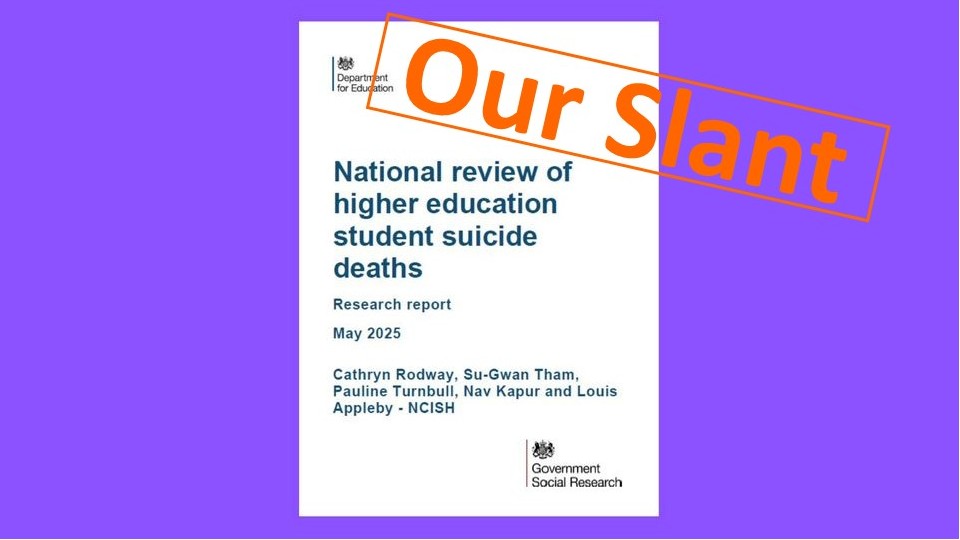The UK Government Department for Education has published its commissioned research report: National review of higher education student suicide deaths. The main aim of the review for the academic year 2023-24 is to promote learning from these incidents to help prevent future deaths. Its findings, limited to England, include the following, to which we also offer additional comment.
83% of students were studying at the time of the incident; only 13% had (formally) interrupted their studies or withdrawn from university.
Only 73% were undergraduates (indicating that postgraduates can also be prone to mental wellbeing issues).
47% of reports identified mental health difficulties as a potential factor (let’s not lose sight of the fact that this means 53% had no reported difficulties).
Only 33% identified evidence of non-attendance (indicating that investment in student class attendance tracking software only nibbles at the edges of solutions).
Only 31% of reports described a student diagnosis or suspected neurodivergent condition (which means more than two-thirds were neurotypical).
Only 22% had a known history of self-harm.
Only 17% expressed suicidal ideation or intent at some time.
The research findings also provide information that debunks 10 other common assumptions about possible causes of suicide or attempted suicide.
The report’s recommendations include enhancing staff training and guidance, improving access to support, better information sharing and involving families in investigations (A Duty of Candour), and reviewing safety measures in university-managed accommodations. These recommendations are very iterative from a sector that has changed very little in the last 100 years – and do they inspire the quantum shift in consciousness that is clearly needed?
As the #forthe100 bereaved families state: “The report offers nothing new. It highlights cracks we’ve already spoken about, makes empty statements about ‘needing a better system’ and avoids the heart of the issue.”
“Heart” is the definitive word. The document Compassionate Communication in Higher Education, produced by ARC (Academic Registrars’ Council), and its insightful introduction from Professor Edward Peck, Chair of Higher Education Mental Health Implementation Taskforce, offers five Commitments to be adopted:
1. Culture of Kindness
2. Mindful Communications
3. Timely Communications
4. Inclusivity
5. Reflection and Continuous Improvement
Each of these Commitments is accompanied by a minimum of six Principles.
However, the method by which institutions are held to be accountable is, as always, left for them to devise for themselves. The saying “money talks” does seem to apply. Unless accountability is incentivised by a correlation to received external funding, then already overstretched staff and governors cannot be expected to fully align their hearts with their heads and hands, so to speak. So whilst there may be pockets of good practice, it is patchy and lacks traction.
There is a clear lack of ownership and a neglect of any timescales. Further examples of this are seen in the extremely slow adoption of the University Mental Health Charter and in Anti-Racism measures within HE establishments. The former failed the UK Government directive for all institutions to be signed up by 2024, and the request has been extended a further two years to September 2026. The latter, through the voice of Professor Nadira Mirza, Director, The Race Institute (at Leeds Trinity University), states that little progress has been made in the last decade and beyond.
Through the LifeRoute initiative, Caring on Campus, its collaboration of students a staff expound a different strategy. One that embraces a systems thinking approach that fully aligns with the one offered by the aforementioned ARC, is logical, systematic, sustainable, and insists on pulling us into a higher level of humane consciousness. – “Wicked problems cannot be solved at the same level of consciousness that created them.”
How do we do this? Caring on Campus proffers a Five-Point Framework:
1. Using proven resources, we get to the core of knowing the “Who I am” that goes beyond all physical references and worldly tangibles. How to forge our truth through the expression of our values – a clarity that enables us to shape meaning, purpose, self-belief, authenticity, and an understanding of mattering.
2. We facilitate your practice of inner alignment to give voice effectively to your values and introduce tools, such as non-violent communication (NVC), that can be used.
3. We demonstrate how this core ‘inner work’ can then – and arguably, only then – fully and consistently achieve what are so frequently identified as key elements of compassionate communication: empathy, active listening, mutual respect in interactions.
4. We lead you to the experience of self-empowerment, so those actively having ideation of suicide cease to remain silent or to deny themselves help because they (wrongly) consider sharing their thoughts with others as an admission of failure or weakness.
5. We change ‘training’ into ‘being’. So that other staff and students no longer step back from intervention for fear of “getting it wrong”. They have developed the assurance and confidence to make a genuine caring connection without trying to ‘fix it’ by finding the right words to say.
By following these strategies, we go to the grassroots where, over time, we can begin to see a reduced need for non-academic pastoral services and already over-burdened student support, where out-sourced services have somehow to be funded by institutions that face enormous and growing liquidity concerns.
If it is the genuine aim to foster a culture of learning and prevention within higher education institutions to mitigate future risks and improve student wellbeing, then now is the time to apply the ‘flipped thinking’ and new pathways of consciousness that we advocate here.
LifeRoute / Caring on Campus
May 2025

